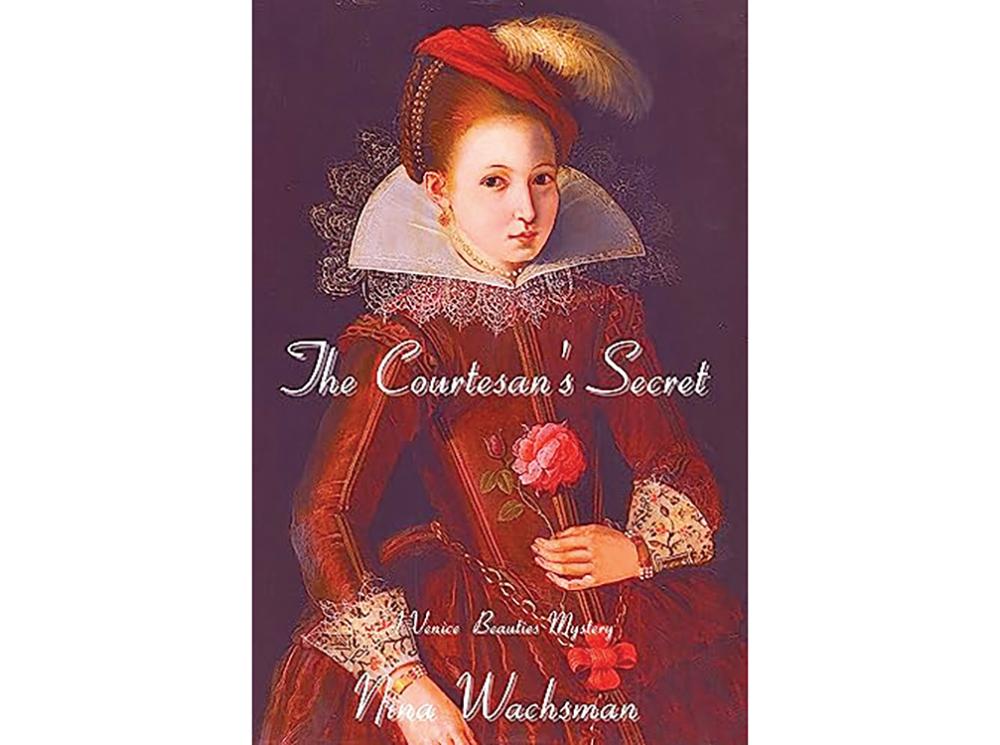
Reviewing: “The Courtesan’s Secret,” by Nina Wachsman. Level Best Books. 2023. ISBN: 978-1-68512-348-2.
Historical fiction is a blend of what really happened and what could have happened. Devotees of the genre are attracted to going back in time to learn about how people lived, and the currents that shaped their society, through the story-telling talent of the author.
If you like fiction served on a platter of historical realism, with colorful characters and page-turning intrigue, drizzled with thoughts about how Jews in a past time period embraced or rejected their identity, get to know author Nina Wachsman. She has just released “The Courtesan’s Secret,” the second of a planned trilogy about 17th-century Venice that includes elements of a real-life memoir left by Rabbi Leon di Modena, meticulous research and stories from her own family history.
The first book, “The Gallery of Beauties,” introduced the fictional Rabbi Leone di Modena, a learned rabbi in the Venice Ghetto; his daughter, Diana, the young widow of a Talmudic scholar, who shared his love of learning but harbors a desire to experience the world beyond the ghetto gates; and other interesting characters. Diana has two brothers—one who has fled the ghetto for the business world and another who becomes a corsair, a Jewish pirate who aids in the rescue of fellow Jews. Diana meets an artist who radically changes her life by painting her portrait and introducing her to the top echelons of Venice society. She meets a courtesan named Belladonna, who seeks to mold her into her protégé. While Diana is not interested in that career path, the two women become friends, and share in solving some mysterious murders going on around them.
“The Courtesan’s Secret” continues the story but focuses more on Belladonna than Diana. Diana struggles with her desire for a life outside the ghetto while staying true to her religion. Belladonna is forced to hide in the ghetto. She must give up power, prestige and privilege to blend in and come to terms with her life story. She has come a long way from being Rachel in a family of New Christians in Jamaica, who was kidnapped to be sold as a slave. She was rescued by Diana’s brother, the corsair Isaak, and taken in by a wealthy family in the ghetto. She left them behind to enter the glittering world of Venice society. Once again, they are protecting Rachel/Belladonna from people who are intent on finding her, thinking that she can lead them to a person looking for her who is in possession of a map that the rulers of both England and Spain want to find. Spain’s bloodthirsty inquisition is still raging. Should she fall into Spanish hands again, she is doomed. But who is the person who wants to share the map with her? And why her? The answer brings her back to the night of her capture and a person she thought had not survived.
An interesting aspect of Belladonna is that she has hidden her Jewish origins but Judaism is a religion and culture she never knew, since she was raised as a New Christian. And the safest place for her to be now that she is in danger is in the Jewish ghetto among people with whom she has very little in common. In a phone interview Wachsman said that is a key part of her approach to writing the story. “The first book was about a character in the ghetto trying to venture out while retaining her tradition,” she explained. “This book is about coming in from the outside and seeing what it looks like.”
Wachsman said one of her goals in writing the books is to show that throughout history, many Jews have struggled with keeping the faith versus becoming part of mainstream society. “There is pressure in the outside world to lose your identity and go into the melting pot, but most people don’t want to throw out what’s been given us as a culture.” She said many people come up to her when she’s giving a talk to say they are very happy she’s getting that message across.
The historical Rabbi Modena filled his autobiography with stories of family struggles. Wachsman borrowed from these to create the characters for the fictional Rabbi Modena’s sons, neither one who is following in their father’s footsteps. She also wanted to share some Jewish history that is not well known. Jewish pirates like Isaac were indeed part of the times. And the Inquisition targeted Jewish converts to Christianity not only in Spain but in the New World.
Wachsman also wanted to show readers how Jews were treated at best as second-class citizens and limited in their choice of occupations. “Many non-Jewish readers have told me they thought Jews were only oppressed under the Nazis. They also wanted to know why there were no Jewish artists. I had to explain that Rome restricted what Jews could do. Jews couldn’t become apprentices. That’s why they became moneylenders.” On a theological level, Wachsman wanted to explore the conflicting Jewish movements of mysticism, with its emphasis on kabbala, and the age of reason and rationalism. She chose 17th-century Venice for her story not only because she is descended from a Venetian rabbinical family, but she was drawn to similarities in the “polyglot” culture of Venice and today’s multicultural society.
“The Courtesan’s Secret” can be read on its own, but like any sequel, is better understood when reading the book that came first. Read together, “The Gallery of Beauties” and “The Courtesan’s Secret” present a fascinating look at Venice, with its glittering palazzos, ruthless aristocrats and Jews trying to live in peace while keeping at bay powerful people who always find them a convenient target. There’s also a budding romance. I eagerly await book three to see where that goes.
For more about Nina Wachsman visit https://www.ninawachsman.com.









